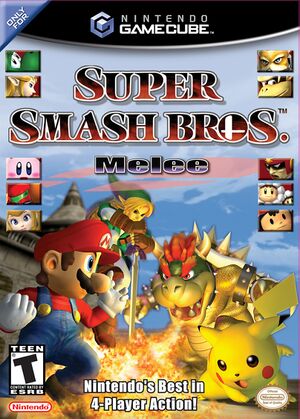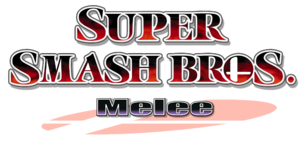No edit summary |
JazzerThighs (talk | contribs) No edit summary |
||
| (139 intermediate revisions by 40 users not shown) | |||
| Line 1: | Line 1: | ||
[[ | {{2 Column Flex|flip=yes|flex1=3|flex2=7 | ||
== | |content1= | ||
[[ | {{Infobox Game | ||
| gamename = Super Smash Bros. Melee | |||
| abbreviation = SSBM | |||
| image = SSBM-cover.jpg | |||
| version = NTSC Version 1.02 | |||
| developer = HAL Laboratory, Intelligent Systems | |||
| publisher = Nintendo | |||
| system = Nintendo GameCube | |||
| netcode2 = Rollback via [https://slippi.gg Slippi] | |||
| resources = [https://blippi.gg Blippi.gg] | |||
| resources2 = [http://www.meleelibrary.com/ Melee Library] | |||
| resources3 = [https://melee.cookbook.gg/ Melee Cookbook] | |||
| resources4 = [https://ikneedata.com/calculator Melee Calculator] | |||
| resources5 = [https://github.com/BroccoliRaab/meleedb BroccoliRaab's ''Melee'' Database] | |||
| resources6 = [[Template:SSBM NavboxLinks|See Links for more]] | |||
| community = [https://smashcords.com/melee SSBM Discord List] | |||
| community2 = [https://reddit.com/r/SSBM /r/SSBM on Reddit] | |||
| community3 = [https://smashboards.com/forums/melee-discussion.12/ SSBM on SmashBoards] | |||
| community4 = [https://calendar.google.com/calendar/u/0/[email protected]&ctz=America/New_York Netplay Event Calendar] | |||
| community5 = [https://meleemajors.com/ Melee Majors Calendar] | |||
}} | |||
|content2= | |||
[[File:SSBM_Logo.png|center|300px]] | |||
Super Smash Bros. Melee is the | {{FP Box|header=Introduction | ||
|content= | |||
'''Super Smash Bros. Melee''' is the second game in Nintendo's [[Super Smash Bros. Series|Super Smash Bros. Series]]. | |||
Released in 2001 (2002 in Europe and Australasia), the series features characters and elements from all over the Nintendo universe. It includes all playable characters from the first game, and also adds characters from their same franchises and even additional franchises such as Fire Emblem. alongside new stages and gameplay modes. | |||
One of the most significant and differentiating factors that Melee brings to the fighting game genre is the unorthodox win conditions; instead of depleting a life-bar, dealing damage rather raises a knockback gauge against the opponent, that then helps enable victory via ring-outs. Another interesting facet is the team battles, allowing teams of two to compete against each other, and the presence of spawning items and weapons (that are usually turned off in competitive play). | |||
The sequel [[Super Smash Bros. Brawl]] was released on March 9, 2008. | |||
}} | |||
{{FP Box|header=Roadmap | |||
|content= | |||
{{Ambox | |||
| image = [[Image:Icon_community.png]] | |||
| border = blue | |||
| type = '''New editors welcome! If you'd like to get an account to edit this wiki, please join the [https://supercombo.gg/discord SuperCombo Discord] and read the #server-and-wiki-info channel for immediate registration.''' | |||
}}<br> | |||
We're just getting started here, and we'll need a lot of help filling in the basics. Head to [[User:Narr/sandbox/Sandbag]] and [[Help:Editing]] to get up to speed with editing if you're new to it. | |||
Currently, our main goal is filling in pages with AttackData templates to meet the layout standards of Sandbag above and Marth's page. We also need writers who can create good starting point move descriptions, and people to do manual frame/move data entry. If you have a special area of interest however, feel free to try and pursue it. | |||
Before adding frame data, it's good practice to check it with frame advance instead of blindly copying it off a site like meleeframedata. | |||
}} | |||
{{Smash Melee}} | {{Smash Melee}} | ||
}} | |||
[[Category: | [[Category: Super Smash Bros. Melee]] | ||
Latest revision as of 14:16, 6 September 2022
| Super Smash Bros. Melee (SSBM) | |
|---|---|
| Version |
NTSC Version 1.02 |
| Developers |
HAL Laboratory, Intelligent Systems |
| Publishers |
Nintendo |
| Systems |
Nintendo GameCube |
| Online Play | Rollback via Slippi |
| Player Resources | |
| Melee Library | |
| Melee Cookbook | |
| Melee Calculator | |
| BroccoliRaab's Melee Database | |
| See Links for more | |
| Community Channels | |
| /r/SSBM on Reddit | |
| SSBM on SmashBoards | |
| Netplay Event Calendar | |
| Melee Majors Calendar | |
Super Smash Bros. Melee is the second game in Nintendo's Super Smash Bros. Series.
Released in 2001 (2002 in Europe and Australasia), the series features characters and elements from all over the Nintendo universe. It includes all playable characters from the first game, and also adds characters from their same franchises and even additional franchises such as Fire Emblem. alongside new stages and gameplay modes.
One of the most significant and differentiating factors that Melee brings to the fighting game genre is the unorthodox win conditions; instead of depleting a life-bar, dealing damage rather raises a knockback gauge against the opponent, that then helps enable victory via ring-outs. Another interesting facet is the team battles, allowing teams of two to compete against each other, and the presence of spawning items and weapons (that are usually turned off in competitive play).
The sequel Super Smash Bros. Brawl was released on March 9, 2008.
| New editors welcome! If you'd like to get an account to edit this wiki, please join the SuperCombo Discord and read the #server-and-wiki-info channel for immediate registration. |
We're just getting started here, and we'll need a lot of help filling in the basics. Head to User:Narr/sandbox/Sandbag and Help:Editing to get up to speed with editing if you're new to it.
Currently, our main goal is filling in pages with AttackData templates to meet the layout standards of Sandbag above and Marth's page. We also need writers who can create good starting point move descriptions, and people to do manual frame/move data entry. If you have a special area of interest however, feel free to try and pursue it.
Before adding frame data, it's good practice to check it with frame advance instead of blindly copying it off a site like meleeframedata.


































